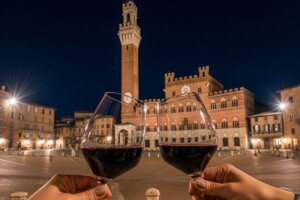The mass retail chains on the Italian market are now worth 70% of sales. And, from the first data on the survey of market shelves in Italy in 2012, carried out by SYMPHONYIRI for VeronaFiere (the full version will be on presented at Vinitaly on April 8th), here are the trends in national consumption: people are drinking a little less wine, but are willing to spend a little more on the bottle of wine they bring to the table. Sales of denomination bottled wine in the 6 euros or more price range grew 3.3% compared to a general 3.6% decline in volume of bottled wine over 2011 (the biggest drop in volume recorded in the last 10 years in supermarkets).
In general, 2012 was a year marked by a sharp increase in prices: +5.5% total of bottled wine, +4.5% per liter for bottles of 75 cl denomination of origin, and even +10.1% for wines in cartons (though volume dropped b 1.7%).
Price changes that affect the distribution of market shares in the various price ranges: denomination wines under two euros (representing 25.2% of the market) lost 18.3% in volume, because many products went up to the central price range, between 2 and 4 euros, which covers the largest market share, almost 50%. Concerning market shares, it is interesting to note that the 4 to 6 euros price range covers 14.8% of the market and the over 6 euros, 5.4%.
Talking about global market shares instead, denomination wines reached 56.1% of wine sales in the big supermarket chains, while the carton, 31.5% (in volume). The average price in general, is 4.28 euros per liter for denomination and bottled wines, and 1.24 euros for wines in cartons.
The best-selling wine in supermarkets is the Italian Lambrusco at more than 14 million liters for a value of 44 million euros. Then follow Chianti, Montepulciano d'Abruzzo, Barbera and Bonarda wines. Nero d'Avola has recorded a great drop (less 30.2%) in volume, due to a 20.8% price increase, which is what has happened to many other wines as well. Among the "emerging" wines, that is, those that registered a higher growth in volume, the top is Pecorino, produced in the Marche and Abruzzo, at 23.8%, followed by Pignoletto, Grillo, Traminer and Falanghina. Among the trends, bubbles are holding very well as they dropped only 0.6% in volume, and private label wines have grown (+1.9% in volume and 9.2% in value), at a market share of 14.7%.
"To counter the tension on the market”, says Alberto Coldani, representing Federdistribuzione and purchasing manager of Carrefour, “the big supermarket chains have organized strong promotional plans that have helped reduce the margins of the chains, and often prevented absorbing high inflation. In addition to the growth of the brand name we also found, and I believe it will be so in 2013, an increase in sales volume - 3.3% in 2012 - for wines costing more than 6 euros, a strong signal that confirms our research: besides convenience, also quality”.
The rise in prices suggests caution and attention in the market analysis and final synthesis, warned Virgilio Romano, Client Service Director at SymphonyIRI Group, coordinator of the research carried out for Vinitaly 2013: "it should be noted what happens in the carton segment, in which there is a substantial price increase associated with a substantial stability in sales volume. This situation can be explained in reality by strong leadership and the significant presence of the brand in the commercial sector. Statistics tell us something of the evolution of consumer tastes: among the emerging wines there are 3 whites like Pecorino, Pignoletto and Grillo in the top positions, hence a preference for a lighter drink, maybe less tied to meals and more to socializing. This is a fact that should make us reflect: tradition must combine new tastes and new modes of consumption to attract new consumers”.
Copyright © 2000/2025
Contatti: info@winenews.it
Seguici anche su Twitter: @WineNewsIt
Seguici anche su Facebook: @winenewsit
Questo articolo è tratto dall'archivio di WineNews - Tutti i diritti riservati - Copyright © 2000/2025








































































































































































































